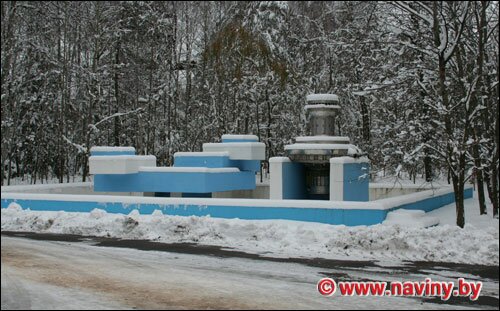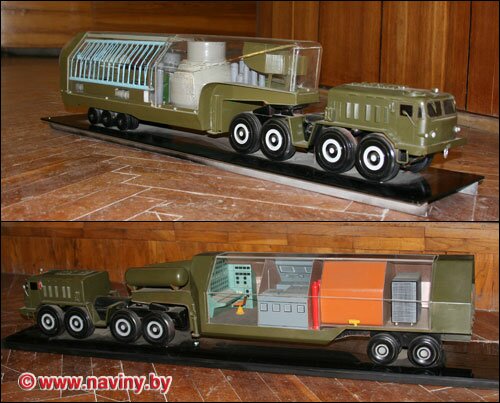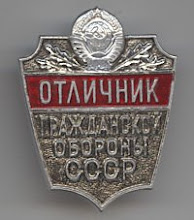The first mobile nuclear generator built on the USSR was the TES-3, completed in 1961. This treaded monster was designed to rumble around the countryside on 4 modified T-10 tank chassis, conveying a 2MWe nuclear plant wherever it might be needed.

The TES-3 Mobile Nuclear Power Plant, 1961
Over the course of the next two decades the mobile nuclear concept was revised by researchers at the Belorussian Academy of Sciences Institute of Nuclear Energy. In the mid-1980s they created the road-mobile Pamir. The Pamir consisted of four heavy trailers, one of which contained a 630kW reactor, another the gas turbine, one which contained a miniaturized control room, and one to house the plant's sizable staff. The reactor and control trailers are illustrated by these models:
The Pamir was designed to operate in a wide variety of conditions--temperatures from -50 to 50 degrees centigrade, with a fuel load sufficient for five years. The reactor utilized HEU and was gas-cooled with dinitrogen tetroxide a single loop, and was part of a 60-ton truck. Operation of the plant required a staff of 28 people. Two examples of the system were completed by 1986, when the Chernobyl accident inspired a campaign within the Soviet government to end the Pamir program. The location of the BSSR's nuclear research institute a mere seven kilometers outside Minsk concerned the protesters, who feared the consequences of an accident with the exotic reactors. Both of the plants were scrapped, leaving only a few mementos of a 300 million ruble development program. One of the reactor vessels was fashioned into a memorial outside the institute:
 A Pamir Reactor Vessel Preserved at the Belorussian Academy of Sciences Institute of Nuclear Energy
A Pamir Reactor Vessel Preserved at the Belorussian Academy of Sciences Institute of Nuclear Energy
The road-mobile nuclear generator is one concept that I very much doubt will see any kind of revival, but it does serve as proof of just how compact and mobile nuclear power can be. Not only can nuclear plants be built in sizes other than "extra large," it is possible to build an entire nuclear power plant that will fit inside a truck trailer. After all, the Soviets did it over twenty years ago.
The Pamir was designed to operate in a wide variety of conditions--temperatures from -50 to 50 degrees centigrade, with a fuel load sufficient for five years. The reactor utilized HEU and was gas-cooled with dinitrogen tetroxide a single loop, and was part of a 60-ton truck. Operation of the plant required a staff of 28 people. Two examples of the system were completed by 1986, when the Chernobyl accident inspired a campaign within the Soviet government to end the Pamir program. The location of the BSSR's nuclear research institute a mere seven kilometers outside Minsk concerned the protesters, who feared the consequences of an accident with the exotic reactors. Both of the plants were scrapped, leaving only a few mementos of a 300 million ruble development program. One of the reactor vessels was fashioned into a memorial outside the institute:
 A Pamir Reactor Vessel Preserved at the Belorussian Academy of Sciences Institute of Nuclear Energy
A Pamir Reactor Vessel Preserved at the Belorussian Academy of Sciences Institute of Nuclear EnergySoviet engineers imagined a variety of uses for the Pamir. The primary purpose of the system was to power military radar outposts in remote parts of the USSR. Part of the appeal of the concept was that these road-mobile nuclear plants could be dispersed under the threat of nuclear war to secure locations, then used to help rebuild Soviet defenses after a nuclear attack. More mundane uses also included civil disasters: after catastrophes like the 1988 Armenian earthquake, or ordinary power outages, the mobile nuclear plants could be used to restore electrical service.
The road-mobile nuclear generator is one concept that I very much doubt will see any kind of revival, but it does serve as proof of just how compact and mobile nuclear power can be. Not only can nuclear plants be built in sizes other than "extra large," it is possible to build an entire nuclear power plant that will fit inside a truck trailer. After all, the Soviets did it over twenty years ago.


2 comments:
It was an interesting idea, too bad they weren't able to complete the program. The US Navy has been operating many mobile nuclear reactors for the past 40 years and has not had a single accident. These would be particularly suitable for service in the North at mines where a fixed reactor would have to be decommissioned at great cost when the mine closed.
I have doubts about the wisdom of this particular system, as it must have been hugely expensive to manufacture in comparison to the generation capacity--640kW is what, around 1000hp? Its advantage was in the enormous amount of energy available without the need for refueling. This makes it ideal for powering military equipment in a post-nuclear environment where no more fuel is likely to be forthcoming for a period of months or years. But in more mundane circumstances, the Pamir seems to be absurd overkill. For industrial purposes, I suspect that something larger would be called for that would be consequently less mobile. Probably some kind of small PBMR (of the sort Rod Adams proposes) would be the best bet. Still, the Pamir is an example of just how versatile nuclear power can be, as well as how creative Soviet engineers were when they were allowed to create something genuinely original.
Post a Comment